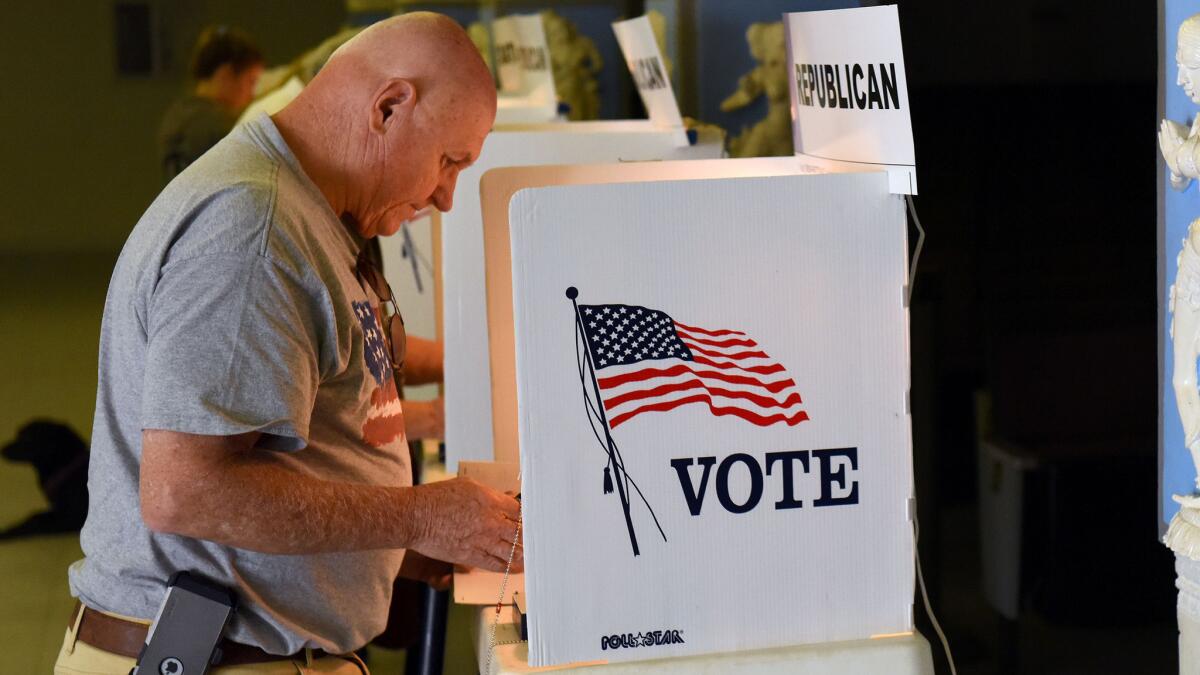Newsom orders new California in-person voting rules for November election

SACRAMENTO — Gov. Gavin Newsom gave California counties permission on Wednesday to limit their in-person voting operations for the Nov. 3 election as protection against the spread of the coronavirus — but only if they also offer three days of early voting, a tradeoff some local officials said could be expensive and challenging.
The decision, detailed in an executive order, came almost one month after Newsom instructed California counties to mail each of the state’s 20.6 million voters an absentee ballot for the upcoming election. In doing so, he noted that voting locations would still be provided, primarily for voters with disabilities and those seeking assistance in a language other than English.
But Newsom’s earlier executive order, issued May 8, didn’t address where and when to set up voting sites, leaving elections officials in limbo on plans for the upcoming presidential election. The cost to implement the latest guidelines could be substantial, exceeding the federal dollars already earmarked for election assistance during the pandemic and further straining county government budgets stretched thin by public health and safety spending.
Newsom’s order offers no information on whether additional state funds will be set aside, though elections funding could be boosted in the state budget the Legislature must send to his desk by June 15.
“Expanded vote-by-mail, coupled with ample in-person voting on and before Election Day, is the best formula for maintaining the accessibility, security, and safety of our election,” Secretary of State Alex Padilla said in a written statement.
Though some large counties, including Los Angeles, already allow several options for early voting, the majority of California’s 58 counties do not. Those counties still conduct elections under traditional rules, with in-person ballots cast on election day at neighborhood polling places — some of which are as small as a homeowner’s garage. That could make safe physical distancing impossible in this fall’s election or lead to long lines in locations with little space for a crowd.
The order issued Wednesday allows those counties to provide a fraction of their normal in-person voting locations, focusing instead on larger facilities with voting devices safely spread out. The sites could include school gymnasiums and auditoriums, though a request made last month by elections officials to require schools to participate went unanswered.
“We are committed to protecting the hard-fought right for Californians to make their voices heard this November, even in the face of a pandemic,” Newsom said in a written statement.
The change presents two notable challenges for counties that have no experience with early voting. First, they will have to operate locations for four consecutive days, requiring more hours on the job for some poll workers or the enlistment of additional volunteers. Many poll workers are seniors who may not participate this year given their heightened risk for COVID-19 infection. The governor’s executive order on Wednesday raised the possibility of county employees being assigned to elections work.
Second, voting locations will have to be prepared to accommodate the thousands of voters who could show up over the four-day period, both those who choose not to vote by mail and new voters who can register as late as election day. Not all of these voters may be eligible to use the same ballot, requiring additional supplies. And because voters could likely choose any of a county’s limited voting locations, poll workers will need more than just an old-fashioned paper printout of voters who live nearby to check eligibility.
Not all counties are expected to use the new rules. Kammi Foote, the registrar of voters in Inyo County, said the consolidation of polling places and extended hours seemed better suited to urban areas in the state.
“In rural counties, the likelihood of a voter going to a different town is very small,” she said. “And expanding to four days is going to be extremely difficult.”
For 15 counties that adopted a 2016 state law swapping out neighborhood polling places for regional vote centers, voting operations will largely remain the same in the three days leading up to election day. But those counties, including Los Angeles and Orange, will be allowed to temporarily skip rules requiring vote centers to be open up to 10 days before the election.
Those counties choosing to offer early voting will also be required to provide drop boxes for ballots, to be in place beginning on Oct. 6 and available through the close of voting on election night.
Newsom’s original order to adjust the November election rules in light of the pandemic drew significant national attention, including criticism from President Trump and other Republican officials. They insisted — wrongly — that the state would mail ballots to people who weren’t registered to vote, including names on inactive voter lists.
As a result, the directive issued on Wednesday includes a provision that clarifies that it “is not intended, and shall not be construed, to mean that voters in an inactive voter registration status shall receive vote-by-mail ballots.”
Still, Republican-led lawsuits have been filed over the governor’s mandate to mail every voter a ballot. Legislation to codify that plan cleared the state Senate’s elections committee on Tuesday.
A second bill seeks to adopt many of the governor’s new rules on in-person voting that would let counties seek additional election changes from Padilla.
The author of that bill, state Sen. Tom Umberg (D-Santa Ana), said Tuesday that it was important to provide Californians more than one safe option for voting this fall.
“But I would suggest that we actually flatten the curve, and if you want to vote in person you do so prior to election day,” Umberg said.
More to Read
Sign up for Essential California
The most important California stories and recommendations in your inbox every morning.
You may occasionally receive promotional content from the Los Angeles Times.











